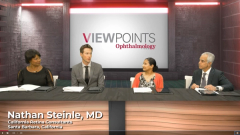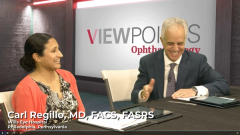
Safety of Faricimab in Neovascular AMD
Expert retina specialists review the safety profile of faricimab compared with other anti-VEGF therapies in AMD.
Episodes in this series

Nathan Steinle, MD: When a new agent comes on the market, we always look at durability, efficacy, and safety, and I think for the retina community, safety is almost at the forefront now. So, talk to me about the safety of faricimab in your hands so far, and have you seen anything in the real world that we should talk about?
Prethy Rao, MD, MPH: I haven’t. I think we always worry about IOI [intraocular inflammation] events, but that has not been my experience so far. I’m not sure about you.
Carl Regillo, MD, FACS, FASRS: I’ve had a good experience, I agree entirely. To turn the clock back a bit, the reason you mention it as a potential issue is we’ve been very fortunate to have anti-VEGF agents that we’ve been using now for years that are very effective. In fact, they’re more or less equally effective, comparable durability, and all very safe, with very low rates of intraocular inflammation. We’re talking moderate to severe inflammation in the range of maybe 1% or 2%. At least that’s what phase 3 registration studies have shown, with ranibizumab, aflibercept.
Then just a few years ago, of course, we had the FDA approval of brolucizumab, which is also an excellent anti-VEGF-A drug. In fact, we have studies that say it dries better and lasts longer than aflibercept. But unfortunately, it’s not used very much because after commercialization, when it was approved and on the market, we started to see much higher rates of inflammation and some very severe cases with vision loss. As we look back, we saw that significant imbalance in phase 3, around 4% vs 1% for brolucizumab vs aflibercept, in the HAWK and HARRIER studies. The good news is with the faricimab AMD [age-related macular degeneration] studies, it was a small imbalance, but very similar IOI rates. That’s reassuring, and there’s much greater scrutiny after the brolucizumab launch, so we’re tracking that closer I think at the level of phase 3 studies and beyond after commercialization.
Nathan Steinle, MD: Yes, it’s impressive there hasn’t been much discussion on safety because, like you said, I think we’re looking extra hard for it too, for inflammation.
Prethy Rao, MD, MPH: I think the TRUCKEE study also is a good example of being able to look at the safety profiles, and the ability to have it being physician- and provider-driven in terms of looking at those outcomes on a higher level has been very helpful.
Transcript edited for clarity
Newsletter
Keep your retina practice on the forefront—subscribe for expert analysis and emerging trends in retinal disease management.

















































